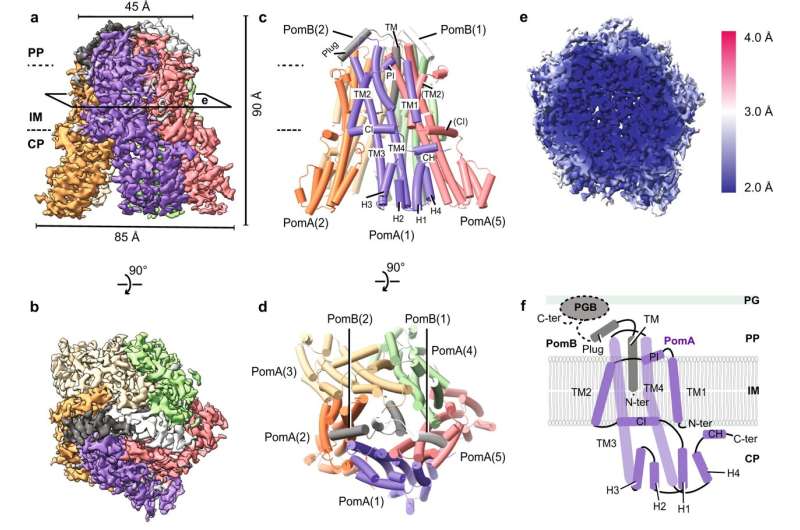This article has been reviewed according to Science X's editorial process and policies. Editors have highlighted the following attributes while ensuring the content's credibility:
fact-checked
peer-reviewed publication
trusted source
proofread
Bacteria like cholera may be crucial in the development of new antibiotics

For thousands of years, the highly infectious disease cholera has been one of the most feared infections in the world. As it should. The mortality rate was high.
Today, there are effective treatments available, such as antibiotics and fluids, which significantly increase survival rates during the illness. However, antibiotic resistance is on the rise, potentially reducing treatment options for diseases like cholera in the future.
Therefore, new knowledge and research that can provide new antibiotic targets are crucial. And this is precisely what a new study from the University of Copenhagen, in collaboration with researchers at other universities, contributes to.
The paper "Ion selectivity and rotor coupling of the Vibrio flagellar sodium-driven stator unit" has is published in Nature Communications. In the study, researchers investigate a bacterium called Vibrio alginolyticus that resembles the cholera bacterium, which is also a Vibrio bacterium.
"The Vibrio bacteria use the energy of the sodium ion gradient across their inner cell membrane to to move around. Now we understand better, why they use sodium ions," says Nicholas Taylor, who is one of the authors behind the new paper. He is associate professor at the Novo Nordisk Foundation Center for Protein Research.
He explains that bacteria move around by a so-called flagellum, a hairy appendage on the bacteria, which rotates and drives the bacteria. The flagellum is powered by an even smaller rotary motor, called PomAB, which powers the rotation of the flagellar motor. Through the study they understand better how the movement of the flagellum is powered.
It is important to understand how bacteria move because they have the ability to relocate from places where they may struggle to survive, to places where they can thrive and multiply. By understanding their movement, researchers may also discover new ways to fight them.
"It is an accessible target, because it's somewhere where in principle drugs can go quite easily," says Nicholas Taylor.
Reconstructed, frozen proteins
By growing cells in the laboratory and storing and examining samples at very cold temperatures, the researchers have produced a reconstructed version of the PomAB motor protein complex of the Vibrio bacteria, which they are investigating in the study.
"We make a lot of the protein of interest and then purify it and very rapidly freeze the sample so the molecules are surrounded by glass-like ice. Then we put it in the electron microscope, and by imaging it, if we have all the different orientations, we can reconstruct what the molecule looks like," says postdoc Haidai Hu, also behind the new study. He adds,
"That is what we are interested in, because now we have something like a map, and in that, we can build an atomic model of our protein."
Flagella rotate, and when they rotate, they make the bacterium move. But it requires power to rotate, and this is the part that Nicholas Taylor and his colleagues now know a lot more about.
"The flagellum is turning and propelling the bacterium, but something needs to provide power. Because all bacteria have this energized inner membrane, they have other proteins that make a so-called ion gradient. You could think of it as a way of storing energy to be used for other things, like a battery. So, the bacteria put a lot of ions on one side of the membrane, and when these ions naturally flow through the small PomAB motor, they allow PomA to rotate around PomB. Because PomB is anchored to the cell wall and PomA can grab on to the big motor, the flagellar motor, this can rotate the flagellum," says Nicholas Taylor.
Possibly a new target for antibiotics
The research is basic research aimed at making us wiser about what drives bacteria in nature or in the body. However, the research also lays the foundation for further studies and contributes to providing us with insights into what it takes to develop, for example, antibiotics, which are essential to continue controlling diseases like cholera.
"There is more and more antibiotic resistance emerging, and there is less and less antibiotics being developed. The past decades, very few new antibiotics have come to market. And if there are, they often also treat the same pathways of the cells that are already covered with a lot of antibiotics," says Nicholas Taylor.
"So in general it is good to have novel antibiotics that target different cellular mechanisms, especially if they are important for virulence."
More information: Haidai Hu et al, Ion selectivity and rotor coupling of the Vibrio flagellar sodium-driven stator unit, Nature Communications (2023). DOI: 10.1038/s41467-023-39899-z
Journal information: Nature Communications
Provided by University of Copenhagen





















